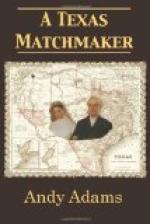Happersett rode down to the San Miguel the next morning to inform Quayle and myself that the mistress was then on the way to spend the night with the widow Annear, and that the rest of us were to report at home the following evening. She had apparently inspected the lines on the Frio, and, finding everything favorable, turned to other fields. I was disappointed, for Esther and I had planned to go up to the Vaux ranch during the visit. Dan suggested that we ride home together by way of the Vauxes’. But Quayle bitterly refused even to go near the ranch. He felt very sore and revengeful over being jilted by Frances after she had let him crown her Queen of the ball at the tournament dance. So, agreeing to meet on the divide the next day for the ride back to Las Palomas, we parted.
The next afternoon, on reaching the divide between the Frio and the home river, Theodore and I scanned the horizon in vain for any horsemen. We dismounted, and after waiting nearly an hour, descried two specks to the northward which we knew must be our men. On coming up they also threw themselves on the ground, and we indulged in a cigarette while we compared notes. I had nothing to conceal, and frankly confessed that Esther and I expected to marry during the latter part of May. Cotton, though, seemed reticent, and though Theodore cross-questioned him rather severely, was non-committal and dumb as an oyster; but before we recrossed the Nueces that evening, John and I having fallen far to the rear of the other two, he admitted to me that his wedding would occur within a month after Lent. It was to be a confidence between us, but I advised him to take Uncle Lance into the secret at once.
But on reaching the ranch we learned that the hunting party had not returned, nor had the mistress. The next morning we resumed our work, Quayle and Cotton at corral building and I at the rock quarry. The work had progressed during my absence, and the number of pieces desired was nearing completion, and with but one team hauling the work-shop was already congested with cut building stone. By noon the quarry was so cluttered with blocks that I ordered half the help to take axes and go to the encinal to cut dry oak wood for burning the lime. With the remainder of my outfit we cleaned out and sealed off the walls of an old lime kiln, which had served ever since the first rock buildings rose on Las Palomas. The oven was cut in the same porous formation, the interior resembling an immense jug, possibly twelve feet in diameter and fifteen feet in height to the surface of the ledge. By locating the kiln near the abrupt wall of an abandoned quarry, ventilation was given from below by a connecting tunnel some twenty feet in length. Layers of wood and limestone were placed within until the interior was filled, when it was fired, and after burning for a few hours the draft was cut off below and above, and the heat retained until the limestone was properly burned.




